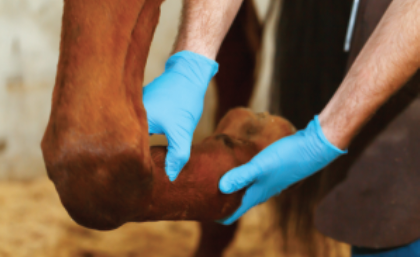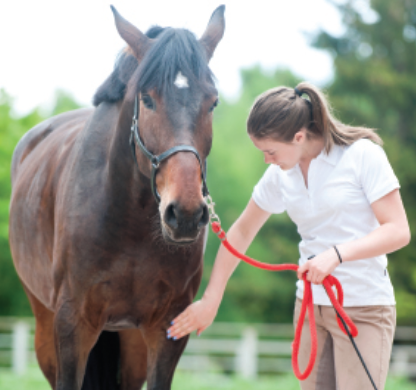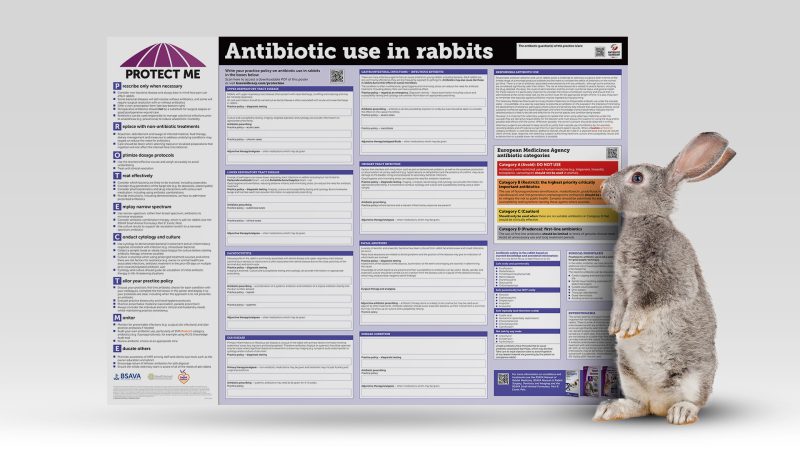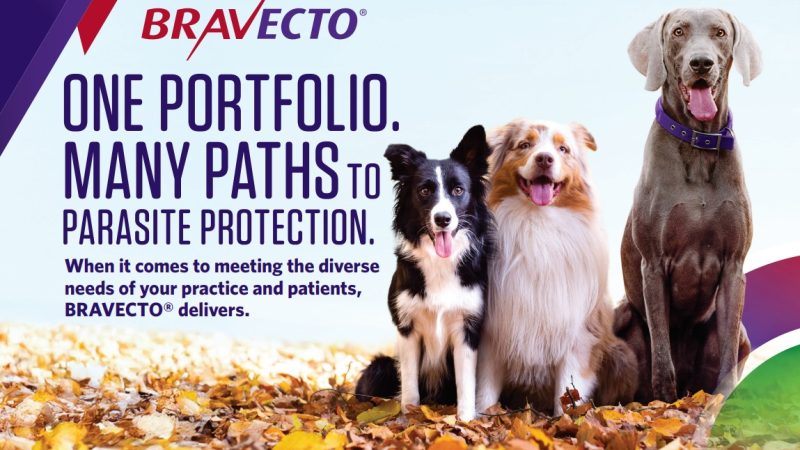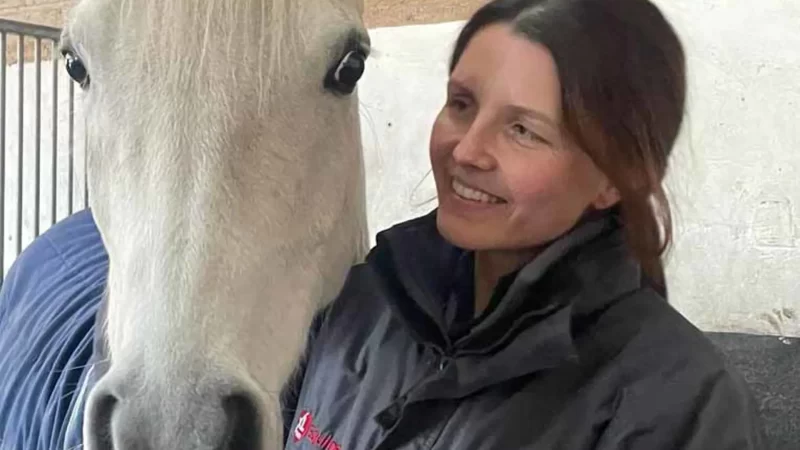Can facial expression be a reliable guide to musculoskeletal pain in horses?
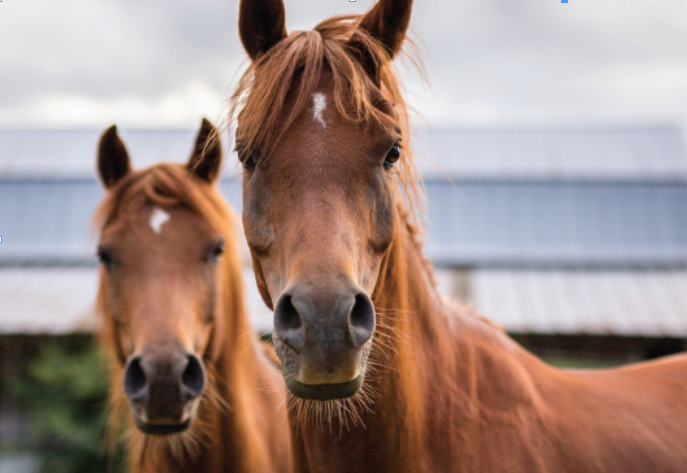
Dr Sue Dyson asks whether we can determine the presence of musculoskeletal pain in ridden horses by facial expression or behaviour?
There are many horses that appear sound in hand but have underlying pain-related musculoskeletal problems.
Horses that experience musculoskeletal pain on the lunge and when ridden, show a variety of gait modifications in an attempt to reduce pain and minimise lameness. These include stiffening the thoracolumbosacral vertebral column, taking shorter steps, alteration of limb flight and increasing body lean.
It has been observed that owners, riders and trainers appear to have a poor ability to recognise signs of pain manifest when horses are ridden. As a result, problems are labelled as training-related, rider-related or behavioural, or people say, “that is just how the horse has always gone”. Consequently pain-related problems generally get progressively worse and, if ultimately presented for investigation, the problems are often too chronic and advanced to manage satisfactorily.
In a study of 506 sports horses in normal work and presumed to be sound, 47 per cent were overtly lame, or had other pain-related gait abnormalities (e.g., stiff, stilted canter), highlighting the size of the problem (Greve and Dyson 2014).
Many members of the veterinary profession have had little training in pain recognition and have had limited education in identification of low-grade lameness and recognition of musculoskeletal pain as a cause of poor performance. By comparison of clinically sound horses and those with musculoskeletal pain, and horses with musculoskeletal pain before and after diagnostic analgesia has improved lameness, we have recognised that certain signs may reflect pain when horses are ridden, for example, unwillingness to go, spookiness, tail swishing, ears back, mouth opening, change in eye posture and expression, flaring nostrils, leaning on the bit, tenseness, crookedness, bucking, going above the bit, being behind the bit, head tossing, resisting, bolting, rearing, and sweating disproportionately to the amount of work done. However, this requires evidence-based validation.
Study
We have completed four parts of a five-part study. In part one, we assessed the ability of people from a range of professional backgrounds to assess facial expressions based on still photographs (Mullard et al., 2016). The objectives were to develop and test an ethogram to describe facial expressions in ridden horses and to determine whether individuals could interpret and correctly apply the ethogram with consistency among assessors.
An ethogram was developed by reference to previous publications and photographs of 150 lame and non-lame ridden horses. A training manual was created. Thirteen assessors (veterinarians of variable experience, n=4; equine technicians, n=3; equine studies graduates, n=2; amateur horse owners, n=2; equine veterinary nurse, n=1; a British Horse Society Instructor, n=1) underwent a training session and, with reference to the training manual, evaluated still lateral photographs of 27 training heads.
Features were graded as Yes, No or Cannot See (when it was not possible to determine the presence or absence of a feature). The ethogram was adapted and, after further training, the assessors blindly evaluated 30 test heads from non-lame and lame horses.
Intra-class correlation (ICC) and free-margin Kappa tests were used to assess consensus among assessors. For the training heads, single ICC matrix among observers resulted in an overall ICC of 0.50 (95 per cent Confidence Intervals [CI], 0.40-0.62). Four assessors consistently scored differently from the others, with ranges of ICC of 0.20-0.50 (mean 0.41). There was no difference in assessors’ scoring related to their professional backgrounds. For the test heads, mean rater agreement among assessors was 87 per cent. Two assessors still scored consistently differently (0.28-0.50 ICC agreement; mean 0.40) from the remaining 11 assessors (0.44-0.69 ICC agreement; mean 0.56). The mean percentage of overall agreement was 80 per cent and the mean free-marginal Kappa value was 0.72, standard deviation (SD) ± 0.22. The large SD was the result of inconsistency in assessments of the eyes and muzzle. It was concluded that the developed ethogram could reliably be utilised to describe facial expressions of ridden horses by people from different professional backgrounds.
In part two, the objective was to determine if, based on assessment of still photographs of the heads of normal (non-lame) horses and lame horses (including some before and after diagnostic analgesia to abolish lameness) undergoing ridden exercise, differentiation could be made between those horses that were experiencing pain and those which were non-lame (Dyson et al., 2017a). It was hypothesised that lame horses would have higher pain scores than non-lame horses; the pain score of lame horses would be reduced after abolition of pain causing lameness by diagnostic analgesia.
The previously developed facial expression for ridden horses ethogram (FEReq) was applied blindly by a trained analyst to photographs (n=519) of the head and neck of lame (n=76) and non-lame (n=25) horses acquired during ridden schooling-type work at both trot and canter. These included images of seven lame horses acquired before (n=30 photographs) and after diagnostic analgesia had abolished lameness (n=22 photographs). A pain score (0-3; 0=normal, 1-3=abnormal) was applied to each feature in the ethogram, based on published descriptions of pain in horses. Pain scores were higher for lame horses than non-lame horses (p<0.001). Total pain score (p<0.05), total head position score (p<0.01), and total ear score (p<0.01) were reduced in lame horses after abolition of lameness. Severely ‘above the bit’, tilting the head, asymmetrical position of the bit, ear position (both ears backwards, one ear backwards and one to the side, one ear backwards and one ear forwards) and eye features (exposure of the sclera, the eye partially or completely closed, muscle tension caudal to the eye, an intense stare) were the best indicators of pain. Application of the FEReq ethogram and pain score could differentiate between lame and non-lame horses. Assessment of facial expression could potentially improve recognition of pain-related gait abnormalities in ridden horses (Dyson et al., 2017a, 2018a).
In part three, we aimed to develop an ethogram for whole-horse behaviour of ridden horses, to assess its repeatability, and to determine whether the ethogram could be used to differentiate between non-lame and lame horses (Dyson et al., 2017b). It was hypothesised that: 1. There would be some overlap in pain/conflict behaviour scores among non-lame and lame horses; 2. Overall, non-lame horses would have a lower pain/conflict behaviour score than lame horses; and 3. The baseline pain/conflict behaviour score in lame horses would be higher than after lameness had been improved by diagnostic analgesia.
The ethogram was developed with 117 behavioural markers and horses were graded twice in random order by a trained specialist using video footage. Overall there was good correlation between two assessments of nine horses (p<0.001; R2=0.91). Unreliable behavioural markers were omitted, reducing the ethogram to 70 markers. The modified ethogram was applied to video recordings of the non-lame horses (n= 13) and lame horses (n=24) (Ethogram Evaluation). There was a strong correlation between 20 behavioural markers and the presence of lameness.
The ethogram was subsequently simplified to 24 behavioural markers, by the amalgamation of similar behaviours which scored similarly and by omission of markers which showed unreliable results in relation to lameness. Following this, the maximum individual occurrence score for lame horses was 14 (out of 24 possible markers), with a median and a mean score of nine (±2 S.D.) compared with a maximum score of six for non-lame horses, with a median and a mean score of two (±1.4). For lame horses the following behaviours occurred significantly more (p<0.05, Chi-square): ears back, mouth opening, tongue out, change in eye posture and expression, going above the bit, head tossing, tilting the head, unwillingness to go, crookedness, hurrying, changing gait spontaneously, poor quality canter, resisting, and stumbling and toe dragging.
Video recordings of 10 lame horses were reviewed by a trained assessor before and after diagnostic analgesia resolved the baseline lameness and improved any gait abnormalities seen in canter (Dyson et al., 2018b). The ridden horse ethogram was applied to each horse under each circumstance that it was ridden. The same rider rode before and after diagnostic analgesia. Occurrence (yes/no) for each of the 24 behaviours was recorded. After abolition of lameness, the total sum score of behaviours (P<0.01), sum of facial (P<0.05), sum of body (P<0.05) and sum of gait (P<0.05) scores were all significantly reduced. Fifteen behavioural markers occurred significantly more often in lame horses (P values 0.00-0.05) and an additional four markers were only seen in lame horses.
In part four, video recordings of 21 horses were reviewed by a trained assessor and 10 untrained assessors (two equine interns [recent veterinary graduates], a junior clinician [a graduate of five years], five equine technicians, and two equine nurses). The videos were assessed in real-time but could be stopped and replayed. The lameness grades ranged from 1-4/8 and the most frequent grade was 2/8.
For the trained assessor, the number of behaviours exhibited by lame horses before diagnostic analgesia ranged from 3-12/24 (median 10; mean 8.9). After lameness and overall performance had been substantially improved using diagnostic analgesia, the number of behaviours ranged from 0-6/24 (median 3; mean 3.0). The difference in behaviour scores between before and after diagnostic analgesia ranged from 2 to 12/24 (median 6; mean 6).
For all the assessors, the decrease in behaviour scores after diagnostic analgesia was significant (Wilcoxon Signed-Rank, p<0.0001). Agreement between the untrained assessors and the trained assessor was moderate and poor before and after analgesia, respectively (Fleiss Kappa 0.49, 0). Each horse acted as its own control (repeated measures design); the only variable was removal of pain. Reduction in behaviour scores after resolution of musculoskeletal pain indicates that these behavioural markers are a likely reflection of pain. It was not possible to hide the presence of lameness which could have biased the assessors. These behaviours may be easier to recognise than low-grade lameness, facilitating identification of musculoskeletal pain.
We use this ethogram on a daily basis when evaluating horses. We believe that the demonstration of ≥ 8 behavioural markers is likely to reflect musculoskeletal pain. However, there is some overlap between lame and non-lame horses, and some lame horses score <8. Persistence of ≥ 8 behavioural markers after lameness is abolished is likely to reflect a concurrent problem meriting further investigation, such as a poorly-fitting saddle or sacroiliac joint region pain.
Sue Dyson, MA Vet MB PhD DEO DipECVSMR FRCVS is a Royal College of Veterinary Surgeons specialist in equine orthopaedics. She is a Diplomate of the European College of Veterinary Sports Medicine and Rehabilitation and an Associate of the European College of Veterinary Diagnostic Imaging. Currently, she is head of clinical orthopaedics in the Centre for Equine Studies at the Animal Health Trust. Sue has lectured internationally and published more than 230 refereed papers in scientific journals, relating to lameness and diagnostic imaging in the horse.
References
Dyson, S., Berger, J., Ellis, A., Mullard, J. Can the presence of musculoskeletal pain be determined from the facial expressions of ridden horses (FEReq)? J. Vet. Behav.: Clin. Appl. Res. 2017a, doi: 10.1016/j.jveb.2017.03.005
Dyson, S., Berger, J., Ellis, A., Mullard, J. Development of an ethogram for a pain scoring system in ridden horses and its application to determine the presence of musculoskeletal pain. J. Vet. Behav.: Clin. Appl. Res. 2017b doi:10.1016/j.jveb.2017.10.008
Dyson, S., Ellis, A., Mullard, J., Berger, J. Response to Gleerup: understanding signals that indicate pain in ridden horses. J. Vet. Behav.: Clin. Appl. Res. 2018a, 23: 87-90
Dyson, S., Berger, J., Ellis, A., Mullard, J. Behavioural observations and comparisons of non-lame horses and lame horses before and after resolution of lameness by diagnostic analgesia. J. Vet. Behav.: Clin. Appl. Res. 2018b In press
Dyson, S., Van Dijk, K. Application of a ridden horse ethogram to video recordings of lame horses before and after diagnostic analgesia. Equine Vet. J. 2018 Submitted
Greve, L., Dyson, S. The interrelationship of lameness, saddle slip and back shape in the general sports horse population. Equine Vet. J. 2014, 46: 687-694
Mullard, J., Berger, J., Ellis, A., Dyson, S. Development of an ethogram to describe facial expressions in ridden horses (FEReq). J. Vet. Behav.: Clin. Appl. Res. 2016, doi: 10.1016/j.jveb.2016.11.005


